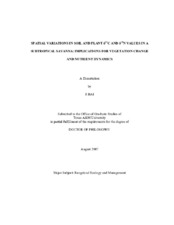| dc.description.abstract | Grass-dominated ecosystems in many regions around the world have experienced increased abundance of woody plants during the past 100 yrs. In the Rio Grande Plains of southern Texas, subtropical woodlands, dominated by C3 trees/shrubs capable of symbiotic N2-fixation, have become significant components of landscapes that were once dominated by C4 grasslands. Upland areas in this region now consist of small discrete clusters and large groves of woody vegetation embedded in a grassy matrix, while lower-lying portions of the landscape are dominated by closed-canopy woodlands. I used soil δ13C in conjunction with aerial photography and geostatistics to quantify landscape-scale vegetation dynamics in uplands of this savanna parkland. Spatial patterns of soil δ13C in grids and transects traversing woody patches indicated larger woody groves were formed from small discrete clusters of woody plants that spread laterally and eventually coalesced. Soil δ13C contour maps revealed some clusters are currently growing rapidly towards each other and might coalesce into groves in the near future, while some clusters remained relatively stable. Kriged maps of soil δ13C provided a strong spatial context for future studies aimed at understanding the functional consequences of this change in landscape structure. The dominant invading woody plant, honey mesquite (Prosopis glandulosa), was important in determining the spatial pattern of soil δ13C, supporting the hypothesis that they serve as recruitment foci and facilitate the establishment of subordinate woody species. Leaf δ15N values suggested that the N2-fixing mesquite influenced the N nutrition of nearby non-N2-fixing shrubs, thus, suggesting a mechanism by which mesquite could facilitate establishment of other woody species. In closed-canopy drainage woodlands, however, spatial patterns of soil δ13C were no longer controlled by the presence of mesquite, but by the amount of soil organic carbon and soil texture. The positive correlation between silt+clay and soil δ13C indicates that the formation of organomineral complexes and microaggregates may slow SOC turnover rates and favor the persistence of C4-derived SOC from the original grassland. This study enhances our understanding of potential patterns, causes and consequences of grassland to woodland conversions which are underway today in many grass-dominated ecosystems around the world. | en |


